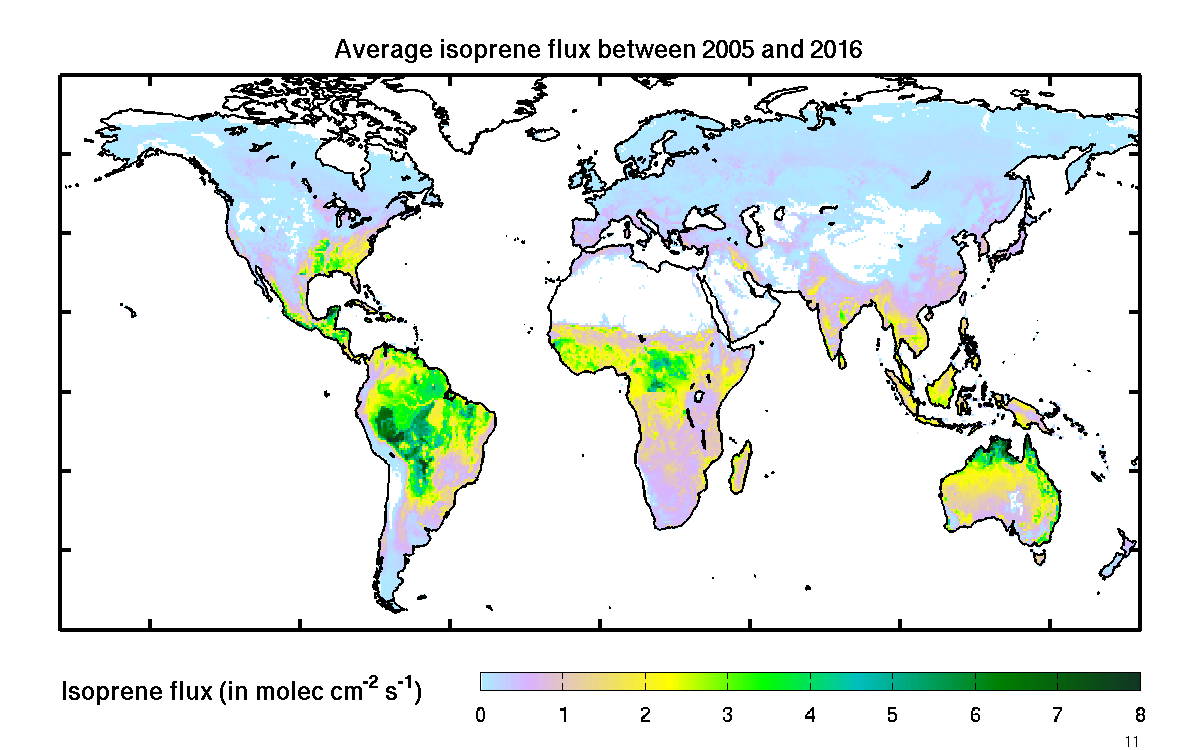MEGAN-MOHYCAN : Isoprene emission inventory 2005-2016
View the data

Download
Here we provide a global dataset from 2005 to 2016. Monthly averaged emissions (in molec cm-2 s-1) are available in NetCDF format: 720 longitudes from 0.25 to 359.75° W, 360 latitudes from 89.75° N to 89.75° S, 12 months.
The dataset does not account for soil moisture stress, i.e. gamma_SM=1 (Guenther et al. 2012).
The corresponding monthly soil moisture stress activity factors (gamma_SM) are available here:
About the dataset
Biogenic emissions of isoprene are calculated using the MEGANv2.1 model (Guenther et al. 2006, 2012, Stavrakou et al. 2014) coupled with the MOHYCAN multi-layer canopy model (Müller et al. 2008). The flux is expressed as Flux=EF * [(1-LDF) * gamma_TLI * gamma_LAI + LDF * 0.55 * gamma_TLD * gamma_P * LAI ] * gamma_age * gamma_SM, where EF (mg m-2 h-1) is the emission factor under standard conditions (Guenther et al. 2006), and LDF is the light-dependent fraction of the emissions (Guenther et al. 2012).
The response to temperature (T), solar radiation (P), leaf age, soil moisture (SM), and leaf area index (LAI) are accounted for by the activity factors gamma. The calculation of light attenuation and leaf temperature in the different layers follows Müller et al. (2008), and Bauwens et al. (2018). Stavrakou et al. (2018) neglect soil moisture stress (gamma_SM=1). To derive isoprene estimates considering the soil moisture stress, one should multiply the monthly emissions provided above by the gamma_SM fields.
References
- Bauwens, M., Stavrakou, T., Müller, J.-F., Van Schaeybroeck, B., De Cruz, L., De Troch, R., Giot, O., Hamdi, R., Termonia, P., Laffineur, Q., Amelynck, C., Schoon, N., Heinesch, B., Holst, T., Arneth, A., Ceulemans, R., Sanchez-Lorenzo, A., and Guenther, A.: Recent past (1979–2014) and future (2070–2099) isoprene fluxes over Europe simulated with the MEGAN-MOHYCAN model (2018), Biogeosciences, accepted.
- Guenther, A., Karl, T., Harley, P., Wiedinmyer, C., Palmer, P. I. and Geron, C. (2006). Estimates of global terrestrial isoprene emissions using MEGAN (Model of Emissions of Gases and Aerosols from Nature). Atmospheric Chemistry and Physics, 6 (11), 3181-3210.
- Guenther, A., Jiang, X., Heald, C. L, Sakulyanontvittaya, T., Duhl, T., Emmons, L.~K. and Wang, X. (2012). The Model of Emissions of Gases and Aerosols from Nature version 2.1 (MEGAN2.1): an extended and updated framework for modeling biogenic emissions. Geoscientific Model Development, 5 (6), 1471-1492.
- Müller, J.-F., Stavrakou, T. Wallens, S., De Smedt, I., Van Roozendael, M., Potosnak, M.~J. et al. (2008). Global isoprene emissions estimated using MEGAN, ECMWF analyses and adetailed canopy environmental model. Atmospheric Chemistry and Physics, 8, 1329-1341.
- Stavrakou, T., Müller, J.-F., Bauwens, M., De Smedt, I., Van Roozendael, M., Guenther, A. et al. (2014). Isoprene emissions over Asia 1979-2012 : impact of climate and land use changes. Atmospheric Chemistry and Physics, 14, 4587-4605.
- Stavrakou, T., Müller, J.-F., Bauwens, M., De Smedt, I. Van Roozendael, M. and Guenther, A. (2018) Impact of short-term climate variability on volatile organic compounds emissions assessed using OMI Satellite formaldehyde observations, Goephysical Review Letters, in review.






